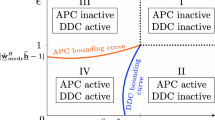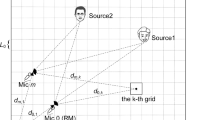Abstract
This paper addresses the estimation of Relative Transfer Function (RTF) between microphones from noisy recordings. We utilize an incomplete initial measurement of the RTF, which is known for only several frequency bins. The measurement is completed by finding its sparsest representation in the time domain. We propose to perform this reconstruction by solving a Second-Order Cone Program (SOCP). Free parameters of this formulation represent distance of the completed RTF from the initial estimate. We select these parameters based on the theoretical performance of the initial estimate. In experiments with real-world data, this approach achieves a significant refinement of the RTF, especially in scenarios with low signal-to-noise ratios.
This work was supported by The Czech Sciences Foundation through Project No. 14-11898S.
Access this chapter
Tax calculation will be finalised at checkout
Purchases are for personal use only
Similar content being viewed by others
Notes
- 1.
The right channel \(X_\mathrm{R}\) as well as H are typically delayed by a few samples due to possible acausality of \(H_\mathrm{RTF}\). We omit this detail here for the sake of simplicity of the notation.
- 2.
The variance of FD under the model is also derived in [2] and could be taken into account. The bias, however, seems to have a larger influence on the entire accuracy of FD; we therefore focus on the bias.
- 3.
The kurtosis-based selection appears to be efficient when the frequency components of the target signal have non-Gaussian distribution while those of the noise are Gaussian; see Sect. 5 in [5]. In real-world situations, this is often satisfied when the target signal is speech and the noise is quasi-stationary.
- 4.
- 5.
- 6.
References
Koldovský, Z., Málek, J., Tichavský, P., Nesta, F.: Semi-blind noise extraction using partially known position of the target source. IEEE Trans. Speech Audio Lang. Process. 21(10), 2029–2041 (2013)
Shalvi, O., Weinstein, E.: System identification using nonstationary signals. IEEE Trans. Sig. Process. 44(8), 2055–2063 (1996)
Parra, L., Spence, C.: Convolutive blind separation of non-stationary sources. IEEE Trans. Speech Audio Process. 8(3), 320–327 (2000)
Talmon, R., Gannot, S.: Relative transfer function identification on manifolds for supervised GSC beamformers. In: Proceedings of the 21st European Signal Processing Conference (EUSIPCO), Marrakech, Morocco, pp. 1–5, September 2013
Koldovský, Z., Málek, J., Gannot, S.: Spatial source subtraction based on incomplete measurements of relative transfer function. IEEE Trans. Speech Audio Lang. Process. (2015)
Koldovský, Z., Tichavský, P.: Sparse Reconstruction of Incomplete Relative Transfer Function: Discrete and Continuous Time Domain. In: Accepted for a Special Session at EUSIPCO 2015, Nice, France, September 2015
Takahashi, Y., Takatani, T., Osako, K., Saruwatari, H., Shikano, K.: Blind spatial subtraction array for speech enhancement in noisy environment. IEEE Trans. Audio Speech Lang. Process. 17(4), 650–664 (2009)
Nesta, F., Matassoni, M., Astudillo, R.F.: A flexible spatial blind source extraction framework for robust speech recognition in noisy environments. In: Proceedings of the 2nd CHiME Workshop on Machine Listening in Multisource Environment, pp. 33–40, June 2013
Domahidi, A., Chu, E., Boyd, S.: ECOS: An SOCP solver for embedded systems. In: Proceedings of European Control Conference, Zurich, pp. 3071–3076, July 2013
Benichoux, A., Simon, L.S.R., Vincent, E., Gribonval, R.: Convex regularizations for the simultaneous recording of room impulse responses. IEEE Trans. Signal Process. 62(8), 1976–1986 (2014)
Hadad, E., Heese, F., Vary, P., Gannot, S.: Multichannel audio database in various acoustic environments. In: International Workshop on Acoustic Signal Enhancement 2014 (IWAENC 2014), Antibes, France, pp. 313–317, September 2014
Author information
Authors and Affiliations
Corresponding author
Editor information
Editors and Affiliations
Rights and permissions
Copyright information
© 2015 Springer International Publishing Switzerland
About this paper
Cite this paper
Koldovský, Z., Málek, J., Tichavský, P. (2015). Improving Relative Transfer Function Estimates Using Second-Order Cone Programming. In: Vincent, E., Yeredor, A., Koldovský, Z., Tichavský, P. (eds) Latent Variable Analysis and Signal Separation. LVA/ICA 2015. Lecture Notes in Computer Science(), vol 9237. Springer, Cham. https://doi.org/10.1007/978-3-319-22482-4_26
Download citation
DOI: https://doi.org/10.1007/978-3-319-22482-4_26
Published:
Publisher Name: Springer, Cham
Print ISBN: 978-3-319-22481-7
Online ISBN: 978-3-319-22482-4
eBook Packages: Computer ScienceComputer Science (R0)




